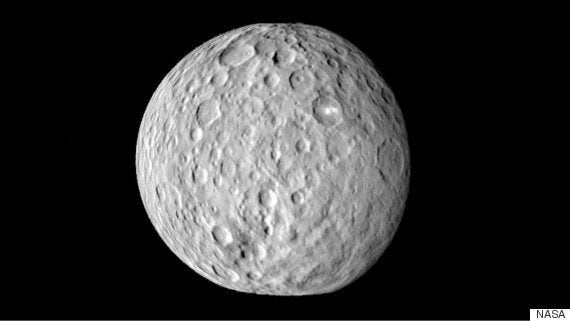NASA's Dawn spacecraft is about to make an historic rendezvous with the dwarf planet Ceres, the largest body in the asteroid belt between Mars and Jupiter.
The Dawn probe, which has futuristic ion propulsion, is due to go into orbit around the mini-world tomorrow.
Recent images of Ceres taken by the spacecraft's cameras have already yielded a mystery that has excited scientists - two bright white spots sitting inside a wide crater.
One theory is that they are the plumes of ice volcanoes. Alternatively, the striking features could be where impacts have dug out surface deposits and exposed the planet's interior.

Scientists believe Ceres could be covered in an icy crust, perhaps encasing a subterranean ocean.
Robert Mase, project manager for the Dawn mission at the American space agency Nasa's Jet Propulsion Laboratory in Pasadena, California, said: "Dawn is about to make history. Our team is ready and eager to find out what Ceres has in store for us."
As Dawn spirals down closer to Ceres, it will be able to take sharper pictures of the spots. Scientists will also look for signs of their appearance changing, which would indicate geological activity.
Ceres was first spotted by Sicilian astronomer Father Giuseppe Piazzi in 1801. As more objects were discovered in the same region they became known as asteroids, or minor planets.
Initially classified as a planet, Ceres was later categorised as an asteroid. In 2006 it was re-classified as a "dwarf planet" along with Pluto and Eris, which lies near the edge of the solar system.
Dawn was launched in September 2007, making its first port of call the giant asteroid Vesta, which it explored for 14 months, capturing detailed images and data.

The two-stop tour was made possible by Dawn's three ion engines, which are far more efficient than conventional chemical rockets. The engines work by using charged metal grids to accelerate ions - electrically charged particles - of xenon gas.
At maximum thrust each engine produces about the same amount of force as that exerted by someone holding a piece of paper. But they use a fraction of the fuel consumed by chemical rockets and can be kept firing for long periods of time, building up high speeds.
Over the course of its mission Dawn is expected to accumulate 5.5 years of thrusting, allowing it to add more than 24,000 mph (38,620km) to its launch velocity using its own power. It will be the biggest velocity change ever attained by a spacecraft engine, eclipsing that of Deep Space 1, another Nasa craft with ion propulsion.
Dawn began its final approach to Ceres in December. Since January 25 the spacecraft has been delivering the highest resolution images of the dwarf planet ever captured.
Jim Green, director of Nasa's Planetary Science Division at the agency's headquarters in Washington D.C., said: "Studying Ceres allows us to do historical research in space, opening a window into the earliest chapter in the history of our solar system. "Data returned from Dawn could contribute significant breakthroughs in our understanding of how the solar system formed."
Ceres is the most massive body in the asteroid belt, roughly spherical in shape with an average diameter of 590 miles (950 km). With an average diameter of 326 miles (525 km), Vesta is the second most massive body in the belt. The asteroid formed earlier than Ceres and is very dry. In contrast, a quarter of Ceres is believed to consist of water.